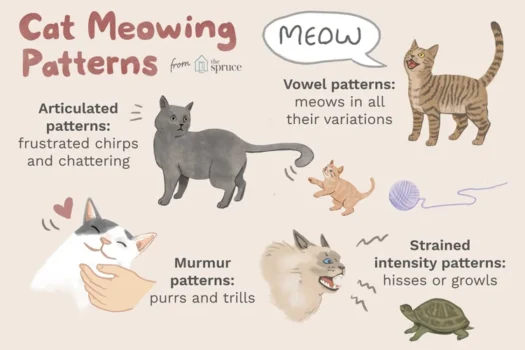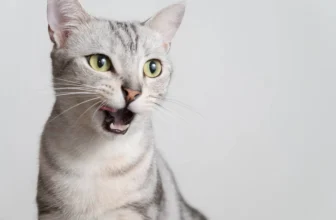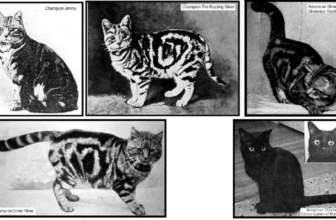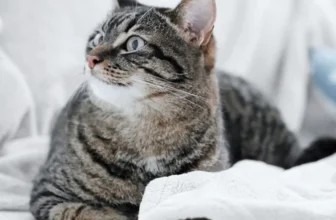As cat owners, we all know that our beloved feline friends can be quite chatty. American Shorthair cats are no exception, and their vocalizations can range from soft meows to loud wails. But what do these various sounds actually mean? It can be perplexing to decipher our cat’s communication, but understanding their vocalizations can help us better understand their needs and emotions. In this article, we’ll explore the different types of meows and purrs that American Shorthairs make, and how to interpret their meaning. So, let’s dive into the fascinating world of cat language.
The Importance of Vocalizations
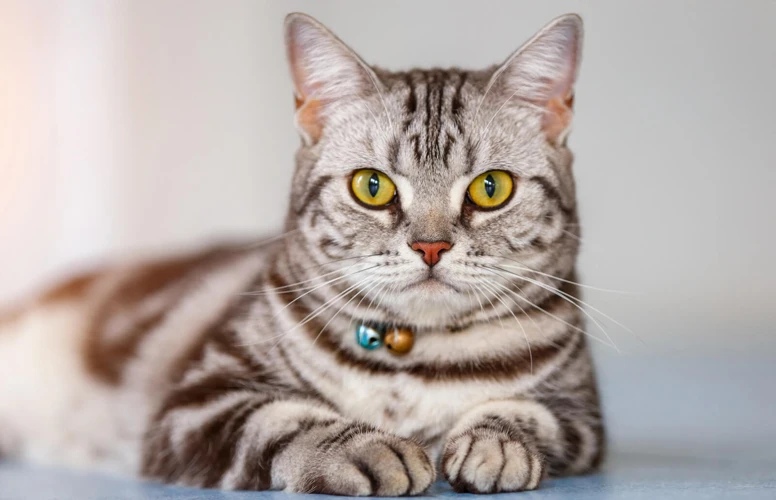
Have you ever wondered why your American Shorthair seems to converse with you in their own language? It turns out that vocalizations are a crucial part of your cat’s communication toolbox. From meows and purrs to trills and yowls, every meow has a meaning. Understanding these vocalizations and what they signify can deepen your bond with your furry friend, help prevent unwanted behavior, and address any issues they might be facing. Read on to learn more about the importance of vocalizations and how to decipher what your cat is trying to say. And if you’re struggling with aggressive behavior, training, or playtime ideas, check out our American Shorthair behavior solutions guide for more tips and tricks.
Why Do American Shorthairs Meow?
Do you ever wonder why your American Shorthair is constantly meowing? It’s actually quite common for cats to vocalize, but the reasons why can sometimes be unclear. Here are a few reasons why American Shorthairs meow:
- Hunger or Thirst: One of the most common reasons why cats meow is to let their owner know that they are hungry or thirsty. If your American Shorthair is meowing constantly, try checking their food and water bowls to see if they need a refill.
- Attention Seeking: Sometimes, cats simply want attention from their owner. They may meow to get your attention, especially if you are busy doing something else.
- Stress or Anxiety: Cats can also meow if they are feeling stressed or anxious. This could be due to a change in their routine or environment, such as moving to a new home or having new people or pets in the house.
- Illness or Pain: If your American Shorthair suddenly starts meowing excessively, it could be a sign that they are in pain or not feeling well. It’s important to take them to the vet to rule out any medical issues.
- Territorialism: Cats can also meow to let other cats know that they consider the area to be their territory. This is usually accompanied by other forms of aggressive behavior, such as hissing or growling.
If your cat is meowing excessively, it’s important to pay attention to their behavior and try to understand what they are trying to communicate. If you suspect they may be in pain or feeling unwell, take them to the vet as soon as possible. Additionally, if you’re having trouble understanding your American Shorthair’s meows or other vocalizations, you can seek the help of a professional cat trainer or behaviorist. They can provide valuable insights and tips on how to communicate effectively with your feline friend.
If your American Shorthair is meowing aggressively, you can learn more about understanding aggressive behavior in American Shorthairs. For tips on how to play with your American Shorthair, check out our article on playing with American Shorthairs. And if you’re interested in training your American Shorthair, be sure to read our article on tips and tricks for training an American Shorthair.
Why Do American Shorthairs Purr?
American Shorthairs are known for their distinctive purring sound, which many cat owners find soothing and comforting. But what does it mean when your furry friend starts purring away?
Purpose of Purring
There are several reasons why cats purr, which are listed below in an html table:
| Reasons | Explanation |
|---|---|
| Contentment and Relaxation | One of the most common reasons why American Shorthairs purr is to express their happiness and relaxation. When cats feel content, they release endorphins that create a sense of calm and well-being, which is often accompanied by the sound of purring. |
| Healing and Soothing | Purring is not only a sign of happiness or relaxation, but also a form of self-medication. The low vibrations produced by purring can help heal wounds, reduce inflammation, and provide relief from pain. It’s believed that the frequency of purring can stimulate the body’s natural healing process, which is why cats often purr when they are injured or sick. |
| Anxiety and Stress | While purring is typically associated with positive emotions, American Shorthairs may also purr when they are anxious or stressed. This is because purring serves as a self-soothing mechanism that helps cats cope with difficult situations. By purring, cats can calm themselves down and feel more secure. |
| Bonding and Communication | Finally, purring can be a way for American Shorthairs to bond with their owners and communicate with other cats. Cats often purr when they are seeking attention or affection, or as a way to establish their territory and communicate with other felines. |
It’s important to note that not all purring is the same, and the reasons for purring can vary depending on the individual cat and the situation. By paying attention to your American Shorthair’s body language and vocalizations, as well as their overall behavior and personality, you can begin to decipher what their purring may be conveying.
Types of American Shorthair Meows
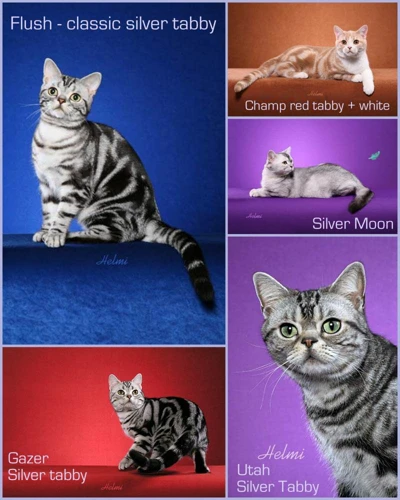
Have you ever wondered why your American Shorthair makes so many different meowing sounds? Each meow has its own unique meaning and purpose, and understanding them can help you better communicate with your furry feline friend. In this section, we will highlight the various types of meows that your American Shorthair may use to communicate with you. From attention-seeking meows to yowling meows, we’ll explore the complexities of your cat’s vocalizations. So, let’s dive in and discover the secret language of American Shorthair meows!
Attention-Seeking Meows
Attention-seeking meows are one of the most common types of vocalizations that American Shorthairs make. These meows are usually high-pitched and insistent, and they are often repeated until the cat receives the desired response. But what exactly are American Shorthairs seeking when they make this type of vocalization?
| Reason | Description |
|---|---|
| Attention | If your American Shorthair is meowing to get your attention, they may be looking to play, cuddle, or get some petting. |
| Hunger/thirst | Some American Shorthairs will vocalize in order to signal that they need food or water. This meow is usually a bit more urgent sounding. |
| Separation anxiety | If your American Shorthair is meowing excessively when you leave, it may indicate that they have separation anxiety and are seeking your presence. |
| Boredom | American Shorthairs are playful by nature, and if they are not being adequately entertained, they may resort to attention-seeking meows to try to engage their owners in play. |
It is important to note that attention-seeking meows can also be a sign of underlying health issues, so it is important to observe your cat’s behaviors and take note of any changes in their vocalizations. In general, responding to your American Shorthair’s attention-seeking meows with affection and attention can help to strengthen the bond between you and your furry friend.
Greeting Meows
Greeting meows are common vocalizations that American Shorthairs use to acknowledge their owners or other cats. This type of meow is usually a happy and friendly greeting and may be accompanied by purring or rubbing against their humans.
Here is a table showing some common characteristics of greeting meows and what they might mean:
| Tone | Possible Meaning |
| Short and high-pitched | A friendly greeting or acknowledgement |
| Long and drawn-out | An excited greeting, possibly with anticipation of play or food |
| Repeated meows | A happy and persistent greeting |
| Soft and gentle | A shy or timid greeting |
It’s important to note that the tone and length of a greeting meow can vary depending on the cat’s personality and the context of the situation. For example, if your cat is feeling scared or threatened, they may not greet you with their usual friendly meow.
When interpreting your American Shorthair’s greeting meows, observe their body language and behavior as well. If they approach you with a relaxed and happy demeanor, it’s likely that they are genuinely happy to see you and are just greeting you in their own special way.
Demanding Meows
When your American Shorthair wants something, they may resort to demanding meows to get your attention. These meows are often louder and more insistent than attention-seeking meows and are usually accompanied by a sense of urgency.
How to recognize:
- The meow is often repeated and persistent.
- The tone is usually high-pitched and urgent.
- Your cat may also make direct eye contact with you and use body language to reinforce their demand.
What it may mean:
- Your cat may be hungry and demanding food.
- They may desire access to a certain area of the house.
- They may want you to play with them or give them attention.
- They may be in need of their litter box cleaned or changed.
It’s important to address your cat’s demands as quickly as possible to avoid escalating their meows into more aggressive behavior. Providing your American Shorthair with plenty of attention and stimulation can also help reduce their need to demand your attention with meows.
Pain Meows
When your American Shorthair is experiencing pain, you may notice them giving off a distinct type of meow. This meow can be high-pitched and desperate sounding, and it’s important to take it seriously.
Here are some ways you can identify if your cat’s meow is a pain meow:
| Indicators | Explanation |
|---|---|
| Vocal Characteristics | Pain meows are typically high-pitched and can be louder or more intense than your cat’s normal meows. They may also sound more frantic or desperate. |
| Behavioral Cues | Your cat may be more lethargic than usual or reluctant to move in certain ways. They may also display other signs of pain, such as limping or favoring a certain area of their body. |
| Context | If your cat is meowing in a different context than usual, such as during grooming or while eating, it could be a sign of pain. |
It’s important to take your cat’s pain seriously and seek veterinary attention as soon as possible. Pain can be a sign of a serious health issue, and early intervention can be critical in ensuring your cat’s health and wellbeing. If you suspect your cat is in pain, don’t hesitate to contact your veterinarian.
Playful Meows
American Shorthairs are known for their playful nature, which is reflected in their vocalizations. Playful meows are a common sound that many owners hear when their American Shorthair is feeling energetic and ready to play. These meows have a distinct tone and pattern that can be recognized with some practice and attentive listening.
The table below provides a detailed breakdown of the characteristics of playful meows:
| Tone: | The tone of playful meows is usually high-pitched and excited, reflecting the cat’s energy and enthusiasm. |
|---|---|
| Pattern: | Playful meows are often repeated in quick succession, with short pauses in between. The cat may also incorporate other vocalizations such as trills or chirps into their playtime sounds. |
| Frequency: | Playful meows are most commonly heard during active playtime sessions, which may occur several times throughout the day. |
| Volume: | The volume of playful meows can vary depending on the cat’s excitement level, but they are usually loud enough to be heard clearly by the owner. |
| Associated behavior: | Playful meows are often accompanied by other playful behaviors such as pouncing, chasing, and batting at toys or other objects. |
If you notice your American Shorthair making playful meows, it’s a sign that they are feeling energetic and ready to play. Engaging in playtime activities with your cat can be a great way to strengthen your bond and provide them with the physical and mental stimulation they need to stay healthy and happy. So next time your cat makes these happy meows, pull out their favorite toys and get ready to play!
Angry or Aggressive Meows
American Shorthairs may emit angry or aggressive meows when they feel threatened, scared, or challenged by another pet or person. These types of meows are usually loud, harsh, and repetitive. They may be accompanied by hissing, growling, swishing of the tail or ears laid flat against the head.
Angry or Aggressive Meows Behaviors
| Behavior | Description |
|---|---|
| Hissing | A sound made by a cat as a warning when feeling threatened. |
| Growling | A low rumbling sound made by a cat to show aggression. |
| Tail Swishing | A quick back and forth movement of the tail to show agitation or frustration. |
| Ears Laid Flat Against Head | A sign of fear or aggression. It shows that the cat is ready to defend itself. |
If a cat is feeling threatened, it’s important to give them space and not approach them. They may require time to calm down before they can feel safe again. Providing them with a safe place to retreat to, like a hiding spot or separate room, can help them feel secure. It is also important to identify the source of aggression and address it accordingly. In some cases, consulting with a veterinarian or animal behaviorist may be necessary.
Important: It is not recommended to physically punish a cat for behaving aggressively. This can only escalate the situation and make the cat feel more threatened and scared.
Trilling Meows
Trilling meows are unique vocalizations that American Shorthairs make. They are often described as a cross between a purr and a meow, and are usually made when a cat is feeling happy or affectionate. American Shorthairs tend to trill more often than other breeds because of their friendly, sociable personalities.
Trilling meows are characterized by a short, rapid vibrational sound that lasts for a few seconds. They usually come with a melody, often rising in pitch towards the end. It’s a sound that’s hard to describe in words, but once you hear it, you’ll never forget it.
There are different interpretations of the trilling meows that American Shorthairs make. Some people believe they are a way for cats to communicate affection or happiness with their owners, while others think trilling is a way for cats to communicate with other cats. In any case, trilling meows are always a good sign, as they indicate that your cat is content and happy.
If you want to encourage your American Shorthair to trill more often, try petting and playing with them. You may find that a few strokes on the head or a favorite toy can bring out the triller in your cat. You can also use treats to reward them when they make their signature sound.
Table: Tips for Encouraging Trilling in American Shorthairs
| Tip #1 | Pet and play with your American Shorthair regularly. |
|---|---|
| Tip #2 | Use a favorite toy to encourage trilling. |
| Tip #3 | Use treats to reward trilling behavior. |
| Tip #4 | Talk to your cat in a soft, gentle voice to create a relaxed environment. |
| Tip #5 | Observe your cat’s body language to see what activities they enjoy the most. |
As with any of your shorthair’s vocalizations, it’s important to pay attention to context, tone, and body language to get a better understanding of what they are trying to tell you. But if you hear trilling, you can rest assured that your American Shorthair is happy and content in your company.
Chirping Meows
Chirping meows are unique and distinctive vocalizations that American Shorthairs make. They are typically high-pitched and sound like a cross between a meow and a bird chirp. Chirping meows are often accompanied by a trilling noise and a flicking of the tail. These vocalizations are usually made when an American Shorthair is excited or happy.
Here are some possible reasons why your American Shorthair may be chirping:
- Excitement: If your American Shorthair is excited about something, such as a new toy or treat, they may chirp their excitement.
- Happiness: Chirping meows can also indicate a happy and content American Shorthair.
- Greeting: Your American Shorthair may chirp as a way of greeting you or another cat in the household.
It’s important to pay attention to your cat’s body language and the context in which the chirping meows occur to accurately interpret their meaning. Keep in mind that not all chirping meows are the same, and your American Shorthair may have their own unique variation of this vocalization.
If your American Shorthair is chirping excessively or in an unusual manner, it’s important to take note of any other behaviors or symptoms they may be exhibiting. Changes in vocalization can sometimes indicate an underlying health issue, so it’s always a good idea to consult with your veterinarian if you are concerned.
Yowling Meows
Yowling meows are intense and powerful vocalizations that American shorthairs use to express their extreme displeasure, frustration, or distress. These meows are often prolonged and guttural, with a distinct tone that usually indicates the cat is in pain or feels threatened.
Causes of Yowling Meows
There are several reasons why American shorthairs may yowl. Some of the most common causes include:
| Cause | Description |
|---|---|
| Illness or Injury | Yowling meows may be a sign that your American shorthair is in pain or discomfort due to an underlying health condition or injury. |
| Stress or Anxiety | Yowling meows may also occur when your American shorthair is feeling stressed or anxious. This could be due to changes in their environment or routine, such as moving to a new home or the addition of a new pet. |
| Attention-Seeking | Some American shorthairs may yowl as a way to demand attention from their owners. This may be particularly true if the cat is left alone for long periods of time. |
| Mating | Unneutered male American shorthairs may yowl as a way to attract a mate. Female cats may also yowl when they are in heat. |
What to Do About Yowling Meows
If your American shorthair is yowling, it is essential to identify the underlying cause and take appropriate action. Here are some tips that may help:
- If you suspect your cat is in pain, take them to the vet as soon as possible.
- Try to identify any sources of stress or anxiety and take steps to reduce them.
- Provide plenty of toys and mental stimulation to keep your cat occupied when you are not home.
- If your cat is yowling for attention, make sure they are getting enough affection and interaction from you.
- If your American shorthair is unneutered, consider having them spayed or neutered to reduce mating-related yowling.
Yowling meows are a powerful communication tool that American shorthairs use to express their emotional states. As a cat owner, it is your responsibility to understand what your feline friend is trying to tell you and take appropriate action to address their needs.
Quiet Meows
Quiet meows might sound like a contradiction, but they are actually a common vocalization for American Shorthairs. These meows are often used to communicate more subtle messages or express a sense of contentment.
Causes of Quiet Meows:
Quiet meows can have different meanings depending on the context and timing of the vocalization. Here are some common causes of quiet meows in American Shorthairs:
| Cause | Description |
|---|---|
| Marking Territory | Quiet meows may be used as a way for American Shorthairs to mark their territory in a less aggressive manner. |
| Asking for Attention | Quiet meows can sometimes be used as a way to ask for attention from their owners without being too demanding or loud. |
| Expressing Contentment | American Shorthairs may use quiet meows to express their satisfaction or contentment with their surroundings or a particular interaction. |
Interpretation:
Quiet meows can be challenging to interpret since they are often subtler than other vocalizations. However, owners can still look for clues in their American Shorthair’s body language, context, and tone to better understand their message.
Here are some factors to consider when interpreting quiet meows:
| Factors to Consider | Description |
|---|---|
| Body Language | Owners can observe their American Shorthair’s body language to see if they are seeking attention or expressing contentment. |
| Context and Timing | Quiet meows that occur in certain situations, such as during a specific activity or in a particular room, can give owners clues about their cat’s message. |
| Tone and Pattern | The tone and pattern of the meow can also provide context for their message, such as indicating contentment or a desire for attention. |
As with any vocalization, owners should pay attention to their American Shorthair’s individual habits and preferences to better understand their messages.
Interpreting Your American Shorthair’s Meows
As a cat parent, you may often find yourself trying to decode your American Shorthair’s vocalizations. We all know that cats meow and purr, but what do these sounds actually mean? In this section, we will explore different techniques and factors that can help you interpret your feline friend’s meows and purrs. By paying close attention to their body language, context, timing, tone, pattern, and other behaviors, you can better understand when your cat is seeking attention, feeling playful, in pain, or even angry. So, let’s dive in and learn how to speak the language of your American Shorthair!
Body Language
Body Language
In addition to vocalizations, American Shorthairs use body language to communicate with their owners. Understanding your cat’s body language is essential in interpreting their vocalizations accurately. Here are some common body language signals that American Shorthairs use and what they mean:
| Body Language Signal | Meaning |
|---|---|
| Tail Twitching | A sign of agitation or irritation. Your cat may be preparing to attack or defend themselves. |
| Purring | A sign of contentment and relaxation. Your cat may be happy or comfortable. |
| Hair Standing on End | Also known as “piloerection,” this is usually a sign of fear or aggression. Your cat is preparing for a potential fight or flight response. |
| Ears Flat Against the Head | A sign of fear or submission. Your cat may feel fearful or anxious in a particular situation. |
| Dilated Pupils | A sign of excitement or fear. This can be an indicator of a stressful situation for your cat. |
| Arching Back | A sign of excitement or aggression. Your cat may be preparing to pounce or attack. |
| Hissing | A sign of aggression or defensiveness. Your cat may feel threatened or may be trying to protect their territory. |
By paying attention to your American Shorthair’s body language, in conjunction with their vocalizations, you can gain deeper insights into the ways your cat is trying to communicate with you. Combining a knowledge of their body language and vocalizations with their overall behavior will allow you to get a fuller picture of your cat’s emotional state and help you respond appropriately to their needs.
Context and Timing
One of the key factors in interpreting your American Shorthair’s meows is understanding the context and timing in which they occur. Here are some examples of how these factors can affect the meaning of your cat’s vocalizations:
- Time of day: Meows in the morning might indicate hunger, while meows at night might indicate a desire for attention or play.
- Location: Meows near the food bowl may indicate hunger or excitement for mealtime, while meows at the front door could indicate a desire to go outside or a response to a visitor.
- Activity: Meows during playtime may be playful and energetic, while meows during naptime might be softer and more relaxed.
- Presence of other animals: Meows could also be a way for your American Shorthair to communicate with other animals in your household or outside. For example, a meow might indicate friendly curiosity or aggressive dominance, depending on the situation.
- Past experiences: Your cat may have learned to associate certain meows with specific desires or needs based on past experiences. For example, if your cat has learned that loud meows result in getting food quickly, they may default to this sound when they are hungry or want more food.
It’s important to pay attention to these contextual factors when trying to interpret your cat’s meows. By understanding the situation in which the meows occur, you can gain a better idea of what your American Shorthair is trying to communicate. However, it’s also important to consider other factors such as body language, tone, and frequency when trying to interpret your cat’s meows. By taking all of these factors into account, you can get a better understanding of what your cat is trying to tell you.
Tone and Pattern
When interpreting the tone and pattern of your American Shorthair’s meows, the following table can serve as a helpful guide:
| Meow Tone | Meaning |
|---|---|
| Short, high-pitched | Your cat is feeling playful or excited. |
| Low, long | Your cat is feeling unhappy or irritated. |
| Rapid, staccato | Your cat may be feeling anxious or afraid. |
| Drawn out, wavering | Your cat is expressing affection and seeking attention. |
| Strong, forceful | Your cat may be feeling angry or threatened. |
In addition to tone, the pattern of your American Shorthair’s meows can also convey key information. A high-pitched, repetitive meow may indicate that your cat is demanding food or attention, while a low-pitched, drawn-out meow may signify that your cat is feeling lonely or wants to spend time with you.
It’s also important to note any sudden changes in tone or pattern, as this may signal a potential issue with your cat’s health. For example, if your cat typically meows in a high-pitched, playful tone but suddenly begins meowing in a low, mournful tone, they may be in pain or discomfort.
By paying close attention to the tone and pattern of your American Shorthair’s meows, you can gain valuable insight into their emotional state and needs.
Frequency and Volume
The frequency and volume of your American Shorthair’s meows can provide crucial insight into their mindset and emotions. Here are some key points to keep in mind:
- High Frequency: Cats tend to have a higher frequency range than humans, and a high-pitched meow can indicate excitement, anxiety, or distress. Conversely, a low-pitched meow may suggest contentment or a desire for attention.
- Loud Volume: A loud meow is often a sign of urgency or frustration, while a quiet meow may indicate shyness or reluctance to communicate.
- Gradual Changes: Changes in frequency and volume can indicate subtle shifts in emotion or intent. For example, a meow that starts off quietly and gradually increases in volume may suggest a growing sense of urgency or frustration.
- Consistency: Pay attention to the consistency of your American Shorthair’s meows. Do they always meow at the same frequency and volume in certain situations? This can be a sign of habitual behavior or a distinct personality trait.
By paying close attention to your cat’s meows and the context in which they occur, you can gain a better understanding of what they are trying to communicate. Of course, each cat is unique and may have their own individual idiosyncrasies, so it’s important to take a holistic approach to interpreting your cat’s vocalizations.
Combining Vocalizations with Other Behaviors
Observing your American Shorthair’s vocalizations is only one piece of the puzzle when it comes to understanding their behavior. To get a complete picture, it’s important to also pay attention to their other behaviors and body language. Here are some behaviors to look out for when your cat meows:
- Posture: Pay attention to your cat’s body posture when they meow. Are they standing tall and confident, or are they crouched and shying away?
- Tail Position: The position of your cat’s tail can also provide important clues. Is their tail held high, indicating confidence, or is it tucked between their legs, indicating fear or submission?
- Eye Contact: Look into your cat’s eyes when they meow. Do they maintain eye contact with you, or do they look away or avoid eye contact?
- Movement: Pay attention to your cat’s movements when they meow. Are they approaching you or moving away? Are they pacing or standing still?
By paying attention to your American Shorthair’s body language in addition to their vocalizations, you can gain a better understanding of what they are trying to communicate. So next time your cat meows, take a moment to observe their posture, tail position, eye contact, and movement to get a more complete picture of what they are trying to tell you.
Conclusion
In conclusion, understanding your American Shorthair’s vocalizations is crucial for building a strong bond with your feline friend. By paying attention to the tone, pattern, frequency, and volume of their meows, as well as considering the context and timing of their vocalizations and observing their body language, you can gain valuable insights into their emotional state and needs.
It’s important to remember that every cat is unique and may have their own variations of meows and purrs that may have different meanings. By spending time with your American Shorthair and learning their vocalizations, you can develop a better understanding of their personality and deepen your relationship with them.
Additionally, knowing the types of meows and purrs that your American Shorthair may use can help you distinguish between attention-seeking, greeting, demanding, pain, playful, angry or aggressive, trilling, chirping, yowling, and quiet meows. This can aid you in identifying when your cat is feeling happy, scared, or in need of attention or medical attention.
Overall, taking the time to explore your American Shorthair’s vocalizations can provide you with valuable insights into their behavior, emotions, and needs. By understanding these vocalizations, you can build a stronger, more fulfilling relationship with your feline friend.
Frequently Asked Questions
What if my American Shorthair doesn’t meow?
Some cats are quieter than others. Pay attention to other forms of communication such as body language and behavior to understand what your cat is trying to tell you.
Why does my American Shorthair meow excessively?
Excessive meowing can indicate a number of things such as stress, boredom, or a medical issue. It’s important to consult with a veterinarian to rule out any underlying health problems.
What if my American Shorthair’s meow sounds different?
A change in the sound of your cat’s meow can be a sign of a health issue. Consult with a veterinarian to ensure your cat’s health and well-being.
What if I can’t understand my American Shorthair’s meows?
It’s common to have difficulty understanding your cat’s vocalizations at first. Pay attention to their body language and context to help interpret their meows.
Why do American Shorthairs purr?
American Shorthairs and most cats purr as a form of communication, either to indicate contentment or as a form of self-soothing when they are anxious or in discomfort.
What if my American Shorthair doesn’t purr?
Some cats do not purr, or may purr very quietly. This is not necessarily a sign of any medical or behavioral issue, and is simply part of their unique personality.
Why do cats trill and chirp?
Trilling and chirping are types of vocalizations that cats use to communicate affection, greeting, and sometimes excitement towards prey. These are often accompanied by body language such as tail wagging.
What does it mean when my cat yowls?
Yowls are often loud and drawn-out vocalizations that indicate distress, discomfort, or an urgent need (such as hunger or the need to go outside). It’s important to investigate the underlying cause of this behavior.
Why do some American Shorthairs meow quietly?
Some cats naturally have a more quiet meow than others. This can also be a sign of shyness or social anxiety, as they may be hesitant to draw attention to themselves.
Can I train my American Shorthair to meow or purr on command?
While training a cat to meow or purr on command is not impossible, it can be challenging and is not recommended as it may cause stress or discomfort for the cat. It’s best to let them communicate in their own natural way.

